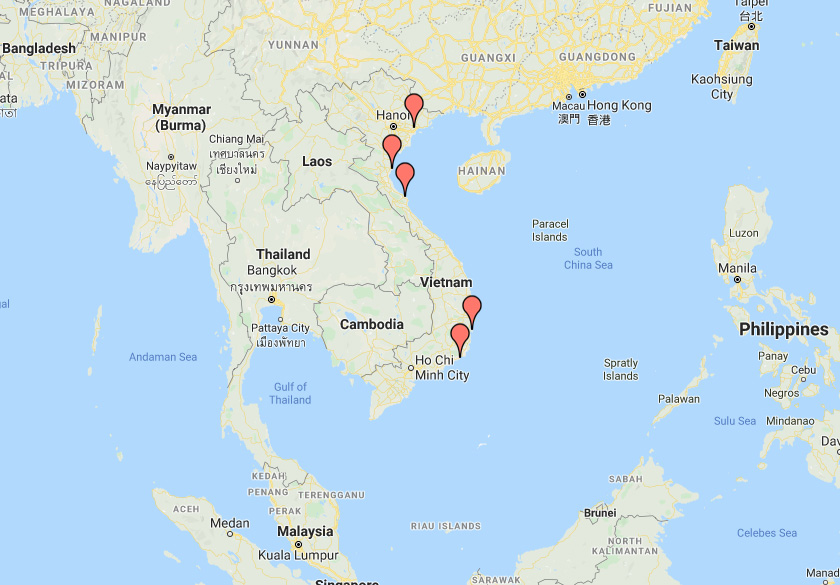The Socialist Republic of Vietnam is a country with a land size about 90% that of Japan and a population of around 98 million [1]. The country forms an S shape stretching north to south, bordering the ocean to its east and Cambodia, Laos, and China to its west and north. I has many islands too.
Vietnam signed the Paris Agreement in 2016.

Source: Google Map
Power Sources
Vietnam’s power generation capacity as of 2018 is 48,573 MW (about 49 GW) [2].
The composition of this capacity by energy source is as follows [2]:
- Coal 18,516MW(38.12%)
- Hydropower 17,031MW(35.06%)
- Gas and oil 8,978MW(18.48%)
- Renewables (small HPPs, wind, solar, biomass) 3,476MW(7.16%)
- Import (from China and Laos) 572MW(1.18%)
In Vietnam, coal is mined mainly in the northern part of the country. However, the country has been a net importer of coal since 2015. It mainly imports from Australia, Indonesia, and Russia[3].
Electrification Rate
The electrification rate in Vietnam was 14% as recently as 1993, but is more than 99% as of 2018 [4].
Power Demand
Power demand has increased at an annual rate of 13% since 2000, and is forecast to increase at an annual rate of 8% until 2030 [5]. According to the Ministry of Industry and Trade’s Report on the Implementation Progress of Power Projects in the Revised Power Development Plan 7 [6] power demand is likely to be met with sufficient supply between 2019 and 2020. However, between 2021 and 2025, despite maximizing oil-fired generation, demand is forecast to gradually outstrip supply, causing power shortages in the southern part of the country.
On the other hand, the report states the following as solutions for controlling demand: 1) To Improve power conservation and actively implement energy auditing programs, especially in the south, 2) Encourage the development of rooftop solar power projects, especially in the south, and 3) Direct subnational governments to promote power conservation in production and consumption.
Vietnam’s power loss rate is 7.04% as of 2018 [2] (for reference, Tokyo Electricity Power Company’s rate is 4.2%), so there is room for improvement. Also, Vietnam already has a power capacity that surpasses that of Thailand, another country in the Mekong region of Southeast Asia which has undergone rapid economic development. Power demand may not grow as quickly as forecast, and technological innovations in energy saving and storage batteries are expected. Hence it is fully conceivable that Vietnam can respond to power demand growth in a manner other than the conventional method of increasing installed generation capacity to match demand.
Renewable Energy
Vietnam has very high renewable energy development potential. Solar power potential is high, particularly in the south. And since a relatively shallow seabed extends from south-central to southern Vietnam, offshore wind potential is also high. [7]
According to the progress report mentioned earlier, renewable energy accounts for 3,800 MW of the 6,900 MW of capacity expected to be operationalized between 2019 and 2020.
According to Vietnam Energy Outlook Report 2019 [8], solar and wind will be more cost-effective than coal in 2030 for the first 20 GW in the best locations. The installed capacity of these two energy sources is expected to reach more than 100 GW by 2050, due to anticipated cost reductions from technological innovation.
This outlook also states that 40% renewable energy in the power mix by 2030 in combination with energy efficiency is feasible, will not increase costs, and is needed to limit fuel imports.
Non Support for Coal-Fired Power
Some of the coal-fired power plant projects listed in PDP 7 rev, especially projects in the south, are delayed. One reason pointed out in the progress report is that local leaders are not supporting the idea of coal-fired power development in their localities. At the planned sites of coal-fired power plants, or where such plants are already operating, problems concerning resettlement and/or health impacts are increasing and resulting in backlashes from residents [9].
PDP 8 is expected to be drafted in mid-2020 and finalized in 2021.Opinions from the provinces are supposed to be reflected into the plan. Thus, it might happen that some coal-fired power projects are eliminated from the list.
The Government of Japan, together with Japanese companies and banks, are exporting coal-fired power plant projects to Vietnam, which are causing pollution and accelerating climate change as such plants emit massive amounts of greenhouse gas. It is time for Japan to exit from coal and strike a path toward decarbonization.
Footnotes
[1] GENERAL STATISTICS OFFICE of VIET NAM
https://www.gso.gov.vn/wp-content/uploads/2021/01/DSLD-2020-EN.pdf
[2] EVN, EVN Annual Report 2018, (2019)
https://www.evn.com.vn/userfile/User/tcdl/files/2019/8/EVNAnnualReport2018(1).pdf
[3] VnExpress.net, “Vietnam urged to stop building new coal-fired power plants”(Nov.5, 2019) (Last browsed on Dec. 27, 2019)
https://e.vnexpress.net/news/business/economy/vietnam-urged-to-stop-building-new-coal-fired-power-plants-4007524.html
[4] World Bank, “Sustainable Energy Future in Vietnam (Speech on Nov. 27, 2018)”(Last browsed on Dec. 27, 2019)
https://www.worldbank.org/en/news/speech/2018/11/27/sustainable-energy-future-in-vietnam
[5] IFC “How a Field of Solar Panels is Brightening Vietnam’s Future(2019)
https://www.ifc.org/wps/wcm/connect/news_ext_content/ifc_external_corporate_site/news+and+events/news/solar-field-panels-is-brightening-vietnam-future
[6] Ministry of Industry and Trade (MOIT), Report on the Implementation Progress of Power Projects in the Revised Power Development Plan 7 (2019)
http://vepg.vn/wp-content/uploads/2019/06/MOIT_Report_58_BC_BCT.pdf
[7] Global Solar Atlas (Last browsed on Dec.27, 2019)
https://globalsolaratlas.info/download/vietnam
Global Wind Atlas (Last browsed on Dec.27, 2019)
https://globalwindatlas.info/en/area/Vietnam
[8] Electricity and Renewable Energy Authority (EREA) in Vietnam under the Ministry of Industry and Trade, and Danish Energy Agency (DEA), EREA & DEA: Vietnam Energy Outlook Report 2019 (2019)
https://ens.dk/sites/ens.dk/files/Globalcooperation/vietnam_energy_outlook_report_2019.pdf
[9] Mekong Eye, Vietnamese provinces say “no” to coal plants – government and industry still want more (Mar. 7, 2019) (Last browsed on Dec. 27, 2019)
https://www.mekongeye.com/2019/03/07/vietnamese-provinces-say-no-to-coal-plants-but-the-government-and-industry-build-more/


